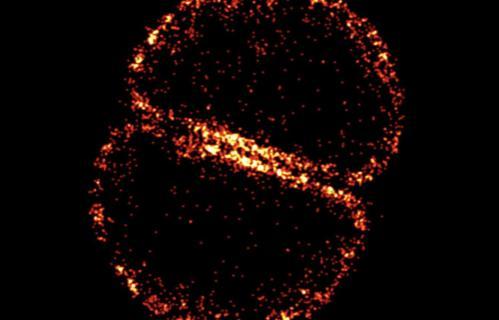 Scientists from the University of Sheffield and UCD have discovered how the hospital superbug MRSA can grow and divide in the presence of antibiotics. The findings, published in Science, pave the way for new approaches to control infectious disease.
Scientists from the University of Sheffield and UCD have discovered how the hospital superbug MRSA can grow and divide in the presence of antibiotics. The findings, published in Science, pave the way for new approaches to control infectious disease.
Methicillin Resistant Staphylococcus aureus (MRSA) is an antimicrobial resistance superbug that causes over 120,000 deaths per year. Given the urgent need for new, more effective antibiotics and a lack of MRSA vaccines, understanding and combating the superbug is crucial.
 The new study reveals MRSA has a double defence mechanism against antibiotics - this new insight offers hope in treating the life-threatening superbug and other infectious diseases. Assistant Professor and Ad Astra Fellow at UCD School of Medicine Dr Rebecca Corrigan is an author on paper, she said, “This discovery is important because it helps us to understand how bacteria can survive antibiotic treatment. It is only through understanding this that we can develop new ways to treat MRSA infections in our efforts to tackle the antimicrobial resistance crisis.”
The new study reveals MRSA has a double defence mechanism against antibiotics - this new insight offers hope in treating the life-threatening superbug and other infectious diseases. Assistant Professor and Ad Astra Fellow at UCD School of Medicine Dr Rebecca Corrigan is an author on paper, she said, “This discovery is important because it helps us to understand how bacteria can survive antibiotic treatment. It is only through understanding this that we can develop new ways to treat MRSA infections in our efforts to tackle the antimicrobial resistance crisis.”
Bacteria, such as MRSA, have mesh like cell walls around them that require enzymes to knit them together. The enzymes are the targets for antibiotics such as penicillin and methicillin. This type of antibiotic has saved millions of lives over the decades.
It has been known for many years that in order to be resistant, MRSA has acquired a new cell wall enzyme that allows it to survive exposure to antibiotics. However, the researchers have found that this alone is insufficient for survival. Their study shows MRSA has also evolved an alternative division mechanism that allows it to replicate in the presence of antibiotics. This previously unknown mechanism is essential for MRSA resistance. By understanding the details of this process, researchers are working towards developing inhibitors that can target MRSA’s novel survival strategy.
Prof Simon Foster of the University of Sheffield’s School of Biosciences said: “This research is very exciting as it has not only uncovered a new mechanism for MRSA, that was hiding in plain sight, but also the ability of the bacteria to divide in an alternative way. These findings have important ramifications for the development of new antibiotics, but also for understanding the fundamental principles that underpin bacterial growth and division. This will provide new ways to tackle this dangerous infectious organism.”
Professor Jamie Hobbs from the University of Sheffield’s School of Mathematical and Physical Sciences said: “This is a fantastic example of how physics and biology can be brought together to understand the pressing societal challenge of antimicrobial resistance. We could not have made the discoveries without this synergy, fusing world leading microscopy, with genetics and microbiology. Our research demonstrates the power of an interdisciplinary approach to address the basic mechanisms supporting the physics of life which are of such importance to healthcare”.
The next step for this research is to determine how MRSA is able to grow and divide in the presence of antibiotics using the new mechanism that has been discovered. The research involves a multidisciplinary collaboration led by the University of Sheffield and is funded by Wellcome and UKRI.
View the full paper: Two codependent routes lead to high-level MRSA published in the journal Science.